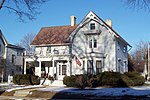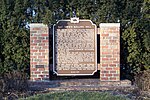Bay View Series
1993 establishments in Wisconsin1993 sculpturesGranite sculptures in WisconsinIron sculptures in the United StatesOutdoor sculptures in Milwaukee
Bay View Series is a public artwork by American artist Peter Flanary (artist) located on the Bay View Public Library grounds, which is on the south side of Milwaukee, Wisconsin, United States. Flanary's 1993 Bay View Series consists of three granite rocks and one chunk of taconite iron ore. All have text on them, and the iron ore piece has a hole in the middle. The largest piece measures approximately 68 x 77 x 28 in.
Excerpt from the Wikipedia article Bay View Series (License: CC BY-SA 3.0, Authors).Bay View Series
South Kinnickinnic Avenue, Milwaukee
Geographical coordinates (GPS) Address Website Nearby Places Show on map
Geographical coordinates (GPS)
| Latitude | Longitude |
|---|---|
| N 42.997721666667 ° | E -87.899646666667 ° |
Address
Milwaukee Public Library - Bay View Branch
South Kinnickinnic Avenue 2566
53207 Milwaukee
Wisconsin, United States
Open on Google Maps







